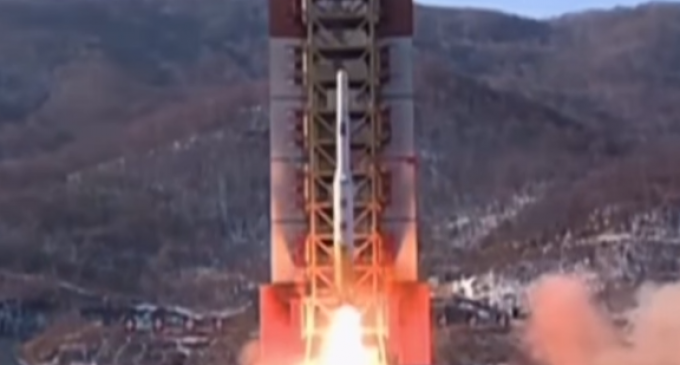
The United States is in “frenzied hysteria” to unleash a nuclear war, according to North Korea’s Foreign Minister Lee Su-yong. In a statement this past Monday, Su-yong said Pyonguyang would without hesitation use their nuclear weapons and have “fully transferred our army from the form of military response to the form of delivering a pre-emptive strike.”
This month alone, North Korea has made other threats, similar to their statement that it “faces the dilemma: a thermonuclear war or peace.” The propaganda video entitled “Last Chance” was released over the weekend, portraying a nuclear attack on Washington D.C.
The four-minute video offers highlights on the history of US-Korean relations and ends with a digitally manipulated sequence showing a missile slamming down in front of the Lincoln Memorial. The US Capitol building explodes in the impact and a message appears on the screen in Korean: “If US imperialists budge an inch toward us, we will immediately hit them with nuclear (weapons).” Temper, temper lil’ Kim, reports Truth and Action.
Is Kim Jung-un crazy enough to follow through with his threats? He certainly is drunk on his perceived power and has dangerous toys in his arsenal. Read more on the next page about the N. Korean threat and their continued testing of ballistic missiles.

yea sure you are…
Su-yong is off his rocker.
Obama will not allow it, don’t these Idiots realize who they are dealing with!…LMFAO
Exactly your taxpayers funds
https://www.youtube.com/watch?v=TFxNPvns7nU
https://www.youtube.com/watch?v=TFxNPvns7nU
I wish we had a leader about now.
North Korea a big joke.
Remember August 6 1945 that’s all folks
“For almost 20 years, the United States has poured money into developing a missile defense system that would be capable of shooting down ICBMs and cruise missiles before they impact their launch targets. Despite the effort, the system has never worked. Last month, the General Accountability Office (GAO) released a report on the Ground-based Midcourse Defense (GMD) program slamming multiple aspects of the program’s design, administration, and field tests.
The problem is, this is a missile system has never been tested against an intercontinental ballistic missile (the major type of threat it’s supposed to defend against) and has only demonstrated, in the words of the Pentagon’s Director Operational Test and Evaluation report, “a limited capability against a simple threat.” That language has been used to describe the situation since 2003.
Missile defense system (theoretically)
In plain English, this is the worst kind of boondoggle — an expensive, protracted program that consumes resources chasing a goal that might be impossible. Yet other countries, like Israel, have successfully deployed a missile defense system. So what’s wrong with the United States’ program?
A vastly different threat
Iron Dome is an anti-missile system developed by Israel to defend against Grad and Qassam rockets fired by insurgents and terrorist groups. These rockets have a typical velocity of about 675 meters per second, or approximately 0.4 miles per second. An ICBM, in contrast, has a velocity of 2.5 miles per second in boost phase and a terminal-phase velocity of around 4.3 miles per second.
Israel’s Iron Dome
Hitting an ICBM with an anti-ICBM has been likened to hitting a bullet with a bullet. Considering that the fastest bullets have a muzzle velocity of about 0.76 miles per second, one could argue that the Israeli Iron Dome system does hit a bullet with a bullet. Trying to hit an ICBM with a GMD-fired missile is an order of magnitude faster than that.
There are three phases during which we could plausibly target an ICBM — the boost phase (initial rocket launch and climb), the midcourse phase (while the ICBM is in sub-orbital flight), and the reentry phase (which is when the ICBM is driving back into the atmosphere towards its target). The boost phase is theoretically easy to target, but requires close proximity, an extremely fast launch cycle, and an insane amount of acceleration — remember, you’re trying to catch a good-sized rocket headed for Low Earth Orbit within 60-300 seconds. The re-entry phase is a poor option because the missile is already on-target — blowing up a nuclear or chemical rocket might just drop the warhead slightly outside of town as opposed to on the city center. That leaves the midcourse phase, which is the preferred target point.
All available evidence, however, suggests that it’s extremely easy for the ICBM to launch countermeasures that would drastically reduce the chances of the anti-ICBM missile from effectively locking on target. IO9 has a rundown of the countermeasure options, and they aren’t pretty.
Why anti-ICBM missile defense can’t work
The fundamental issue with any anti-ICBM missile system is that it’s going to cost orders of magnitude more money to develop an effective interception system than it does to throw more ICBMs at the target. One of the reasons Israel’s Iron Dome system works is because the insurgents it defends against can’t hurl thousands of missiles into Israeli airspace in a matter of minutes. Even so, it’s more of a psychological protective measure than an effective one.
Missile test results
In our case, the US has avoided any such tests of capability and confined itself to smaller, simpler tests against much slower targets — but it continues to build and deploy interceptors like the CE-II, which has never had a successful test. (EKV stands for Exoatmospheric Kill Vehicle). When the GAO went to the DoD for additional data on the status of the program, the DoD was unwilling to share details on its own ongoing evaluations and will continue to deploy vehicles with an unproven capability.
Multiple government agencies have issued scathing reports on the mismanagement of the Missile Defense Agency, noting that the organization had proposed no methods of remedying the massive faults. But in lieu of effective solutions, Congress is happy to just spend more money on the broken ones — without even requiring the agencies in question to provide an accounting of how they’ll fix the problems in the future.”